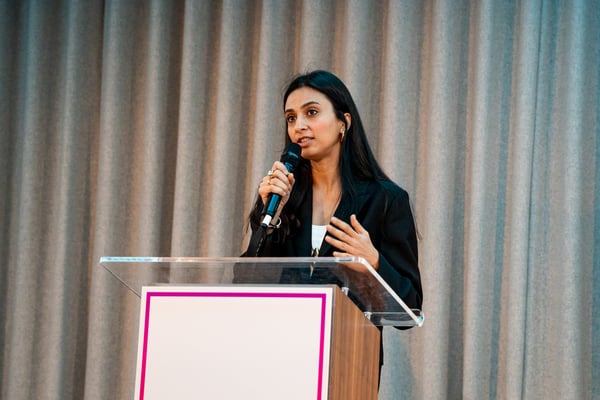How to manage Citizen Experience in government services
.jpg?width=750&name=Managing%20CX%20in%20public%20services%20(1).jpg)
How should public sector bodies rethink the citizen journey to deliver genuine user-centred services? At the Government Transformation Show in November 2021, we brought together an expert panel of service transformation leaders to share best practice and case studies from their organisations.
In this report, we share key takeaways from:
- Anne-Louise Clark - Executive Director, Audit Wales
- Ian Benson - Executive Director of Business Transformation, Disclosure and Barring Service
- Pauline Yau - Head of Public Sector & Education, from session partner Zoom
Anne-Louise Clark - Executive Director, Audit Wales
There's a need for us to step outside of our professional boundaries and think actually, do we really know what's best for individuals? Do we see the services that we're delivering in the context of the whole of their lives, or do we just see it in terms of the mandate to deliver a statutory service?
It's difficult, because people have been delivering some of these services for a long time with great policy intent, and the layers of governance and guidance around that. To suddenly suggest to people that what they've been doing in the past is not as helpful as they initially intended it to be, is a challenge.  People who work in public services and Government don't go into it to make life difficult for people, but the layering of different services can result in exactly the opposite of the goal with unintended consequences.
People who work in public services and Government don't go into it to make life difficult for people, but the layering of different services can result in exactly the opposite of the goal with unintended consequences.
Sometimes it's about challenging ourselves to reflect on the outcomes we’re actually delivering across those different sectors. We even talk about citizens in different ways - in the health service, the citizen is referred to as a patient; in social services, they're either a client or a service user; and in education, they're a learner. We project onto citizens a kind of dimension that makes assumptions about what they're trying to achieve. When they interact with us, it would be great if we could start to talk about what the outcome is that they're wanting to achieve when they interact with our services.
Ian Benson - Executive Director of Business Transformation, Disclosure and Barring Service
There's been a form of regulation and regulated activity for several decades that has iterated over time - CRB is the most commonly known in the present, day along with what is now the DBS. Public sector organisations, especially Government bodies, are used to working within a policy regime where we develop our services as the policy iterates.  So as the legislation iterates, we understand what we need to do, we start building around that and we evolve our services.
So as the legislation iterates, we understand what we need to do, we start building around that and we evolve our services.
One of the biggest catalysts at the DBS was the pandemic, as it was for many people, where it forced us not to operate in the traditional sense of iteration, but actually stand back and identify that we need to do something new - and quickly.
What we needed was not just an Agile strategy, but a strategy for being Agile.
That forced us to put ourselves into the position of the citizen and our customers. The DBS has an ongoing question around who are our customers? Are they employers? Are they citizens? Is it the Government that we're serving? We had to respond rapidly to the surging demand for social workers, nurses and doctors. Tens of thousands of people who'd previously retired from practice returned to practice. We had to provide deep disclosure checks in a really rapid form, and we developed the fast check service for free within a period of weeks in order to support that.
What we needed was not just an Agile strategy, but a strategy for being Agile, because we couldn't launch something, see if it worked, and then come back to the drawing board with it and iterate - we had to resolve the challenge that was in front of us.
This is the balance that we need to adopt more of as a government agency in meeting the policy and legislative agenda, and balancing that with the experience and the views of citizens. Government has those two responsibilities - one is a responsibility for civil society and providing measures to provide those protections in a civil society, but it has to balance that with protecting the civil liberties of individuals.
Pauline Yau - Head of Public Sector & Education, Zoom
Prior to COVID, Zoom already had two million users, but almost overnight, we went to 20 million, which in itself brings challenges. We paused all of the innovation and development of the Zoom platform and pivoted our engineering resources overnight to working on the security features that made sure this new set of users were able to use them in an efficient, safe and secure way.
We had to put all of these features at the fingertips of our users to make sure they were getting the best experience while moving all of the activity that they would have done face-to-face in the past, to an online environment.
Of course the innovation doesn't stop there. We then had to think about how to create positive experiences for customers and users that we hadn't really had to consider before.  Taking healthcare as an example, Zoom is very widely used across the NHS, especially in secondary care. Consultations between a clinician and a patient, or group therapy or group intervention settings where you might be invited to take part in some kind of ongoing mental health treatment, are relevant examples.
Taking healthcare as an example, Zoom is very widely used across the NHS, especially in secondary care. Consultations between a clinician and a patient, or group therapy or group intervention settings where you might be invited to take part in some kind of ongoing mental health treatment, are relevant examples.
A challenge that might arise could be what happens if the host clinician or therapist delivering that session with vulnerable people loses their internet connection? Are we protecting those vulnerable people that are then together in an online environment without any kind of safeguarding or protection? That's been the sort of challenge we’ve continued to innovate and develop for these new use cases.
There’s a long tradition of collaboration in the NHS, where the multidisciplinary team meeting is an established practice. Typically it would take place physically with everybody together in a room discussing a patient or a set of patients. With that now moved online via video meetings, you can have those kinds of conversations about a specific patient, not just with clinical experts, but also bringing in emergency services, the local authority or an educational institution. Doing this remotely has meant that more people can be involved in that conversation, which then leads to the greater collaboration.






